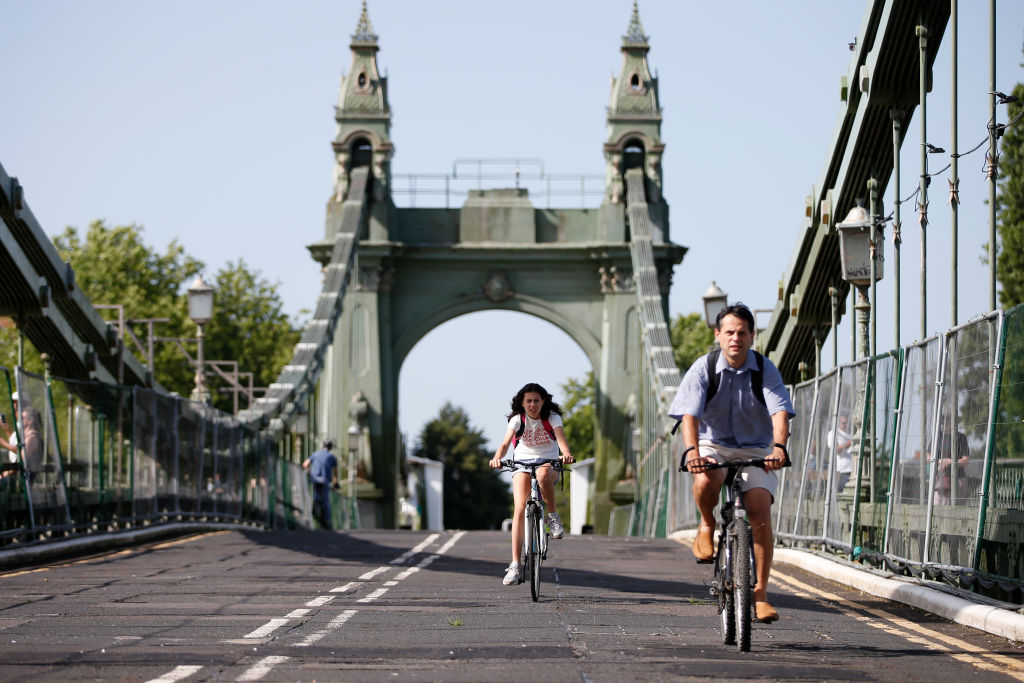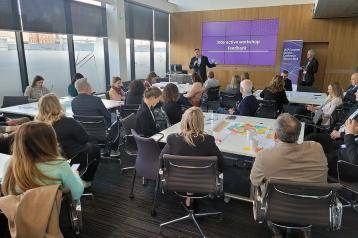
Hammersmith Bridge (pictured) was reopened to pedestrians, cyclists and river traffic on 17 July. PICTURE: GETTY IMAGES
- H&F Leader approves urgent proposal
- Project will save £24m and be delivered more quickly
- Need for temporary closures will be reduced
Hammersmith & Fulham Council has approved an innovative new £6 million plan to stabilise Hammersmith Bridge at significantly below the original expected cost with works completing in under a year.
The council’s specialist engineers Mott MacDonald devised the alternative stabilisation plan which will bring savings of £24m and has now been chosen to replace the existing Pell Frischmann scheme.
H&F commissioned Dr Steve Denton, Head of Civil, Bridge and Ground Engineering at consultants WSP, to compare the two options to stabilise the bridge’s cast iron pedestals. He concluded that the one proposed by Mott MacDonald would be technically superior, implemented more rapidly and more cost efficient than the £30m scheme presented by Pell Frischmann.
As well as saving £24m and reducing the works programme to 46 weeks, the new plan – which has been favourably reviewed by Historic England – is expected to reduce the need for temporary closures. Engineers believe it will also avoid the need to divert the gas mains on the bridge for the stabilisation work.
The proposal was presented to engineers and officials from the Department for Transport (DfT) and Transport for London (TfL) at a meeting with Dr Steve Denton and H&F engineers held on 9 August 2021.
The bridge was reopened to pedestrians, cyclists and river traffic on 17 July. Safety experts have stated that the use of the temperature control system, which enabled the reopening, can only be temporary.
Moving at speed
In order to move at speed to begin the full stabilisation works, H&F Leader Cllr Stephen Cowan has agreed and signed an Urgency Report.
Cllr Cowan said: “We don’t want to lose a single day in delivering the full stabilisation of the bridge to ensure residents on both sides of the river no longer have to deal with closures or the threat of closures.
“Whilst putting the safety of the public first, we believe that the importance of maintaining pace and progress, the real savings achieved by the deployment of the preferred stabilisation works option and the current vulnerability of Hammersmith Bridge demands rapid action.”
Cllr Cowan said, in order to expedite the works at speed, the council will go-ahead and fund the £6m package in anticipation that the DfT and TfL will subsequently reimburse the council with their one-third shares as outlined in the Government’s TfL funding announcement of 1 June 2021.
New plan is significantly more cost effective
Dr Denton’s report states: “The design concept for the Pell Frischmann proposal is to construct an external frame that provides an independent load path, eliminating reliance on the pedestals until they are strengthened and new bearings are installed. Given the uncertainties about the pedestals at the time the concept was first developed, it is entirely understandable why such an approach was initially taken.”
The Mott MacDonald solution involves the use of elastomeric bearings which allow any pressure to be applied equally to all four corners whilst protecting the vulnerable 134 year-old cast iron structure.
Dr Denton said the Mott MacDonald proposal benefits significantly from the insight gained from the refined pedestal analysis engineers have done over the last year.
He said: “As a result, jacking to enable bearing replacement is undertaken using the pedestal itself, with the robustness of the pedestal having been enhanced prior to jacking.”
He concluded: “The Mott MacDonald proposal is significantly more cost effective.”
Whereas the Pell Frischmann plan suggested the driving of piles through historic fabric, Dr Denton said “the Mott MacDonald proposal has lower impact on historic features” and has been favourably received by Historic England.
H&F expects to keep the bridge open to pedestrians and cyclists for the vast majority of the duration of the works, but there may be short programmed periods of closure to allow some works to take place safely. Advance warning of any closures to minimise disruption will be given.
H&F Leader Cllr Stephen Cowan said “Having reopened the bridge to pedestrians, cyclists and river traffic last month, we are keen to press on with the next phase of work. I am grateful for the advice from Professor Denton and look forward to reaching agreement with the Government and TfL on the funding of the stabilisation and full repair works.”
Next steps and funding proposal
H&F is developing a Memorandum of Understanding (MoU) with the DfT and TfL incorporating financial proposals to share costs of the work between the three bodies.
The pedestrian stabilisation plan is the first phase of works on the bridge. The second phase will involve extensive strengthening and full restoration and will allow the bridge to reopen eventually to vehicles.
Dr Denton is now considering the two current options for the strengthening and restoration work – the existing TfL plan and the pioneering Fosters + Partners/COWI proposal for a temporary double decker truss.
Want to read more news stories like this? Subscribe to our weekly e-news bulletin.




